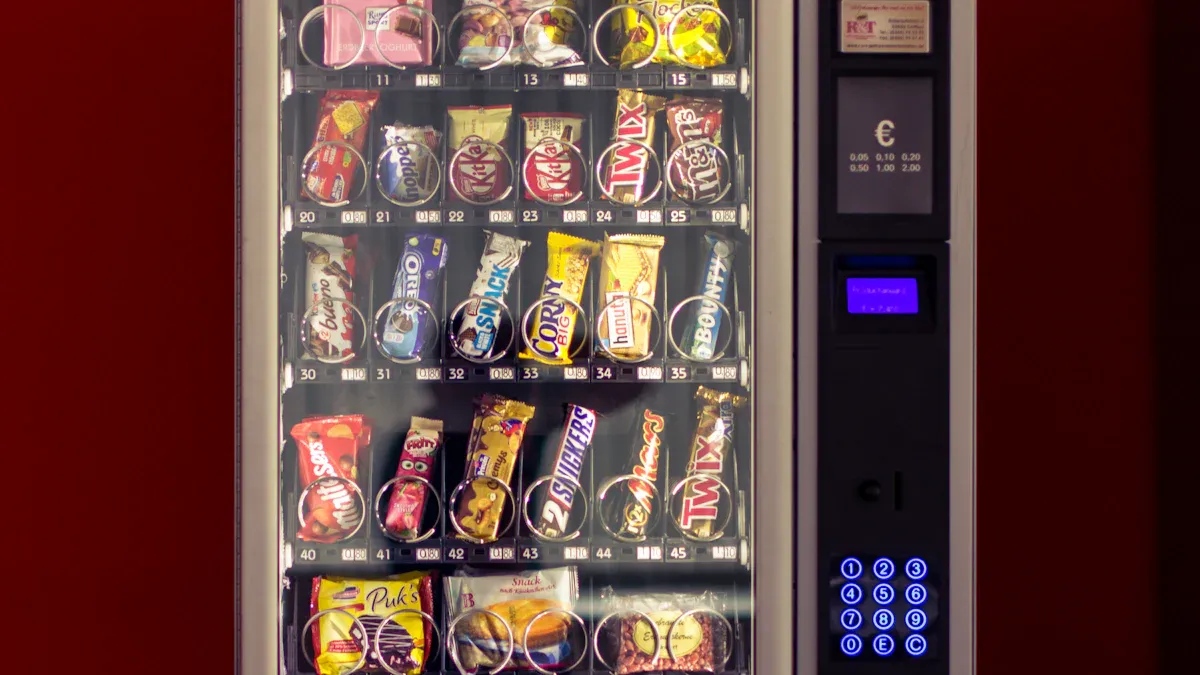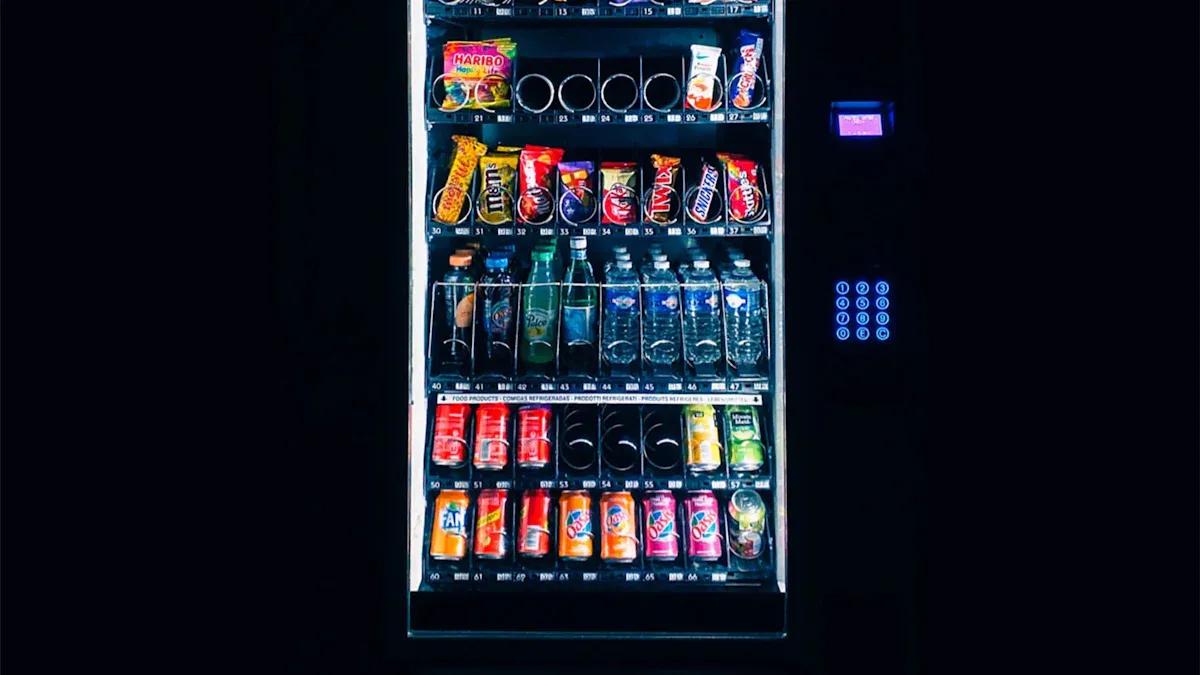Universal Vending Machine Lock: Durable Zinc Alloy Design for Most T-Handle Locks

A Universal Vending Machine Lock keeps machines secure with a strong zinc alloy body. This lock fits most T-handle locks, making it a practical option for many vending machines. Zinc alloy resists damage and daily wear. Security matters because vending machines often contain valuable products and cash. Owners and operators choose this lock to protect their investment and reduce the risk of theft.
Key Takeaways
The Universal Vending Machine Lock uses strong zinc alloy and copper core materials to resist damage, rust, and tampering.
Key retention keeps the key inside the lock when open, preventing lost keys and ensuring machines stay secure.
This lock fits most T-handle vending machine locks and works with many brands, making upgrades easy and versatile.
Installation is simple with basic tools, and regular maintenance like cleaning and lubrication keeps the lock reliable.
Advanced security features like anti-drill plates and electronic key options help protect machines from theft and unauthorized access.
Universal Vending Machine Lock Features

Zinc Alloy Construction
The Universal Vending Machine Lock uses a zinc alloy body for strength and durability. Zinc alloy stands out because it resists damage from daily use. Monroe Engineering describes these locks as having housings and barrels made from zinc alloy, which makes them suitable for many applications. The material helps the lock withstand picking tools and even water. This construction ensures the lock lasts a long time and keeps vending machines secure.
Note: Zinc alloy locks can offer over 10,000 to 30,000 key combinations, making them hard to pick or duplicate.
Copper Core
Inside the lock, a copper core provides smooth operation. Copper resists rust and corrosion, which helps the lock work well in different environments. The copper core also supports the locking mechanism, making it reliable for daily use. Operators can trust that the lock will not jam or fail easily.
Chrome or Nickel Plating
Manufacturers often add a layer of chrome or nickel plating to the lock’s surface. This plating protects the lock from scratches and corrosion. It also gives the lock a shiny, professional look. Chrome and nickel finishes help the Universal Vending Machine Lock stay clean and attractive, even after years of use.
Feature | Benefit |
|---|---|
Chrome Plating | Corrosion resistance, shine |
Nickel Plating | Scratch resistance, durability |
Key Retention
The key retention feature keeps the key in the lock when it is open. This means the operator cannot remove the key until the lock is closed again. Key retention prevents lost keys and helps operators remember to secure the machine after servicing. This feature adds another layer of security to the Universal Vending Machine Lock.
Wide Compatibility
The Universal Vending Machine Lock fits most T-handle locks found on vending machines. This wide compatibility makes it easy for owners to upgrade their security without changing the entire locking system. The lock works with metal and wooden doors, cabinets, and boxes, showing its versatility. Customizable accessories, such as nuts and cams, allow the lock to fit different machine models.
Fits most T-handle locks
Works with various vending machine brands
Supports custom accessories for special needs
Operators can rely on this lock for resistance to tampering, corrosion, and daily wear. The Universal Vending Machine Lock stands as a smart choice for anyone who values security and reliability.
Security Benefits
Tamper Resistance
A strong lock protects vending machines from tampering. The zinc alloy body and copper core make it hard for thieves to break or pick the lock. Chrome or nickel plating adds another layer of defense against tools and weather. Many locks use a design that resists drilling and prying. This makes it difficult for anyone to force the lock open. Operators can trust that their machines stay secure, even in busy or public areas.
Theft Protection
Vending machines often hold cash and valuable products. A secure lock helps prevent theft by stopping unauthorized access. The key retention feature ensures that operators cannot leave the machine unlocked by mistake. Only people with the correct key can open the lock. Some locks also use interchangeable keys, which allow owners to change access quickly if a key is lost or stolen. This flexibility helps reduce the risk of theft and keeps machine contents safe.
Tip: Regularly check the lock for signs of tampering. Quick action can prevent bigger problems.
Key Management
Key management plays a big role in vending machine security. Modern systems use electronic keys and tracking software to control who can access each machine. These systems offer several benefits:
Prevent lock picking, drilling, and duplicate keys.
Allow time-controlled access, so only authorized people can open machines at certain times.
Record audit trails, showing who accessed a machine and when.
Use key tracking solutions for 24-hour accountability.
Make lost keys useless by refreshing electronic keys daily.
Enable quick changes to access rights with cellular-enabled authorization.
Reduce internal theft and provide evidence for investigations.
With these features, operators gain better control and peace of mind. Good key management not only protects machines but also improves service and efficiency.
Installation and Maintenance

Installation
Installing a vending machine lock requires only a few basic tools. Most operators can complete the process in minutes. First, select the correct lock size for the T-handle. Remove the old lock by turning the key and pulling it out. Insert the new lock into the handle slot. Secure it with the provided nut or cam. Tighten the nut with a wrench to ensure a snug fit. Test the lock by turning the key and checking the handle movement. If the lock does not turn smoothly, adjust the position and retighten. Operators should always follow the manufacturer’s instructions for best results.
Tip: Keep the installation area clean to prevent dust or debris from entering the lock during setup.
Maintenance Tips
Regular maintenance extends the life of vending machine locks and keeps machines secure. Operators should follow a schedule based on preventive and condition-based maintenance strategies. These approaches help reduce failures and improve reliability.
Clean the lock cylinder with a dry cloth every month.
Apply a small amount of graphite lubricant to the keyhole twice a year.
Inspect for signs of rust or corrosion during each service visit.
Check the lock’s operation after heavy use or exposure to harsh weather.
Replace worn or damaged locks promptly to maintain security.
Maintenance schedules use reliability metrics like Mean Time Between Failures (MTBF) to plan service intervals. Too many checks increase costs, but too few risk lock failure. Condition-based maintenance, such as monitoring for stiffness or unusual sounds, helps operators act before problems occur.
Troubleshooting
Operators sometimes face issues with vending machine locks. Common problems include lost keys, damaged locks, or key code errors. A step-by-step approach helps resolve these issues quickly.
Lost Keys: Order replacement keys from the manufacturer to restore access.
Damaged Locks: Replace worn or broken locks to keep machines secure.
Key Code Issues: Upgrade to modern key systems or use master keys if codes fail.
Jammed Locks: Clean the keyhole and apply lubricant. If the lock remains stuck, remove and inspect for internal damage.
Universal Key Concerns: Consider customized locks for higher security if universal keys pose a risk.
Note: Regular troubleshooting and prompt repairs prevent operational disruptions and protect valuable machine contents.
Why Choose This Lock
Advantages
The Universal Vending Machine Lock stands out for its superior security and long-lasting durability. Manufacturers use strong materials such as steel, brass, and zinc alloy to build these locks. Protective coatings like chrome or nickel help the lock resist rust and corrosion. These features allow the lock to perform well in many environments, from humid locations to outdoor vending spots.
Security features go beyond the surface. Many locks include anti-drill plates between the housing and cylinder. These plates stop thieves from drilling into the lock. Hardened metals make tampering and forced entry much harder. Some electronic versions remove visible keyholes and use infrared key fobs. This design prevents lock picking and drilling. Electronic locks also offer programmable access, so operators can change combinations or set time-limited keys for extra control.
Operators benefit from key tracking systems that provide 24-hour accountability. Audit trails show who accessed the machine and when, which helps prevent theft and improves labor efficiency.
A table below highlights the main advantages:
Feature | Benefit |
|---|---|
Zinc Alloy & Steel Body | High durability, resists damage |
Chrome/Nickel Plating | Rust and corrosion resistance |
Anti-Drill Plates | Stops drilling attacks |
Electronic Key Options | Prevents picking, allows access control |
Key Tracking | Improves security and accountability |
Use Cases
Vending machine operators use these locks in many settings. Schools, hospitals, and office buildings rely on them to protect snacks and drinks. Outdoor vending machines in parks or transit stations need strong locks to withstand weather and tampering. Refrigerated vending machines benefit from electronic locks with tight seals, which reduce cold air leaks and lower energy costs.
Security kits and reinforced steel panels protect areas like bill validators and card readers. These upgrades make break-ins more difficult and protect valuable assets.
The Universal Vending Machine Lock adapts to different machine types and locations. Operators choose this lock for its proven performance in high-traffic and high-risk areas.
The Universal Vending Machine Lock offers strong protection with its zinc alloy design. Operators gain durability, wide compatibility, and enhanced security for their machines. This lock stands up to daily use and resists tampering. Owners can trust it in busy or high-risk locations. Upgrading to this lock helps protect valuable assets. For better vending machine security, operators should consider installing this reliable solution today.
FAQ
How does the universal vending machine lock improve security?
The lock uses a zinc alloy body and copper core. These materials resist tampering and picking. Key retention ensures operators cannot leave the machine unlocked. Many models also include anti-drill plates for extra protection.
Can operators install the lock without special tools?
Most operators can install the lock using basic hand tools. The process involves removing the old lock, inserting the new one, and tightening the nut. No advanced skills or equipment are necessary.
What should operators do if they lose a key?
Operators should contact the manufacturer or authorized dealer for a replacement key. Some locks support interchangeable cores, so owners can change the lock cylinder for added security.
Does the lock fit all vending machines?
The universal design fits most T-handle locks. It works with many vending machine brands. Custom accessories help the lock fit different models and door types.
How often should operators maintain the lock?
Operators should clean the lock monthly and lubricate it twice a year. Regular checks for rust or damage help keep the lock working well and extend its lifespan.
See Also
Key Tips For Maintaining Vending Machine Locks And Doors
The Impact Of Key Vending Machines On Locksmith Industry
Understanding The Expenses Of Custom Vending Machines
Features And Advantages Of Vending Machines Accepting Large Bills
